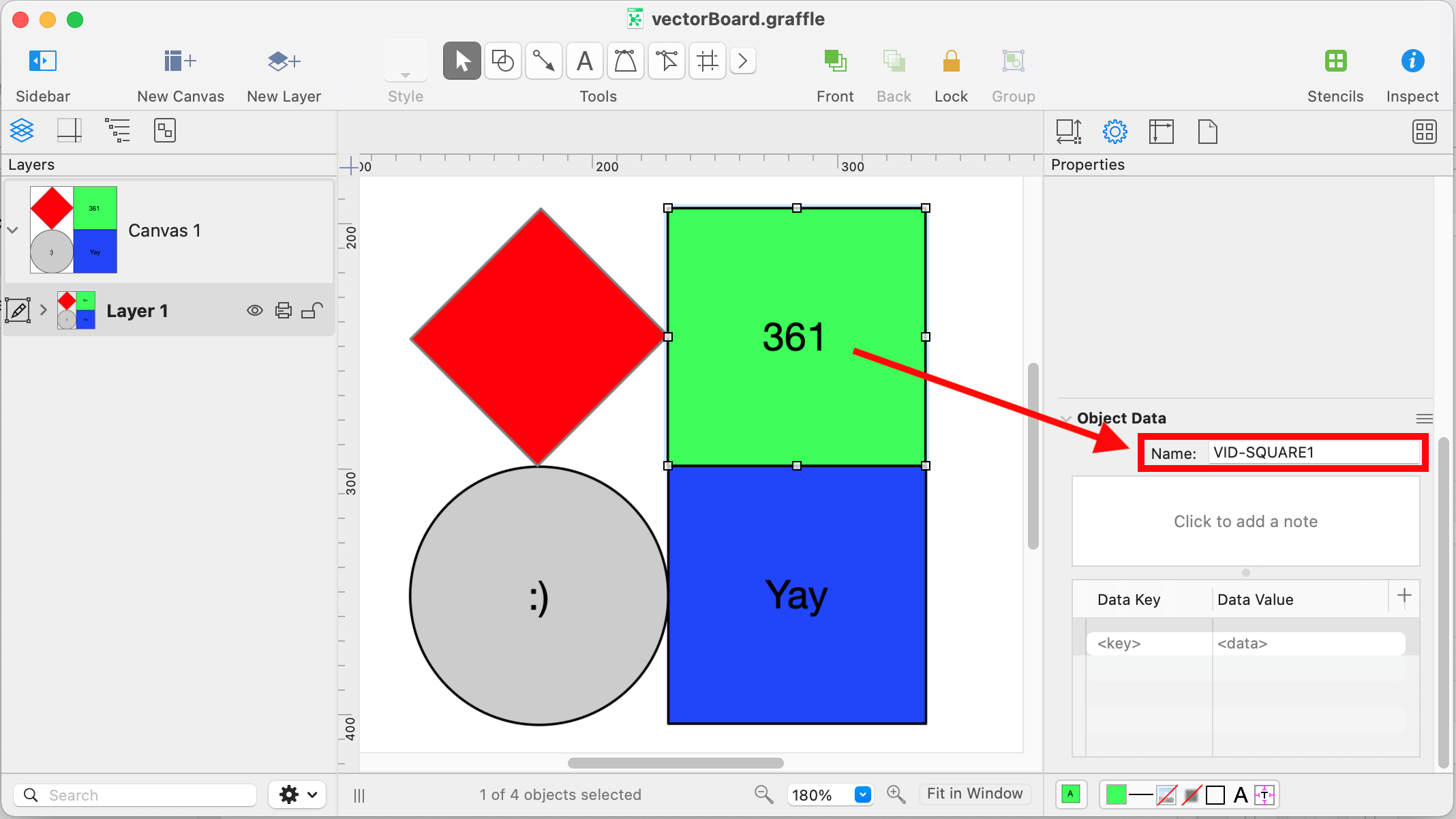Minimal DOM transformer that patches SVG files exported by OmniGraffle. Use this to prep your SVG files for integration in a webapp.
This software patches Omnigraffle-exported svg for convenient use as interactive web-UIs.
Like most of us, I favour designing a good game UI in a graphics program rather coding pure HTML and CSS. That being said, the interest of this repo is to support embedding SVGs into an HTML page, i.e., export of a fancy OmniGraffle SVG for display in a board game web implementation?
However, there are some caveats, which is why I set up this repo:
- Game elements (the disposition of game material on a board) changes throughout gameplay. That is, you'll have to modify the UI's DOM tree. Unfortunately most SVG editors will not let you place element ids, so it's not trivial to get hold of the objects to modify. This patcher converts textual tags (set within onmigraffle) into standard svg/xml element IDs.
- Similar to previous point, some zones in a gameUI are simply placeholders for nested internal UIs. This patcher transforms marked zones so they contain a translation tag to ensure all elements of a nested UI are where they are supposed to be.
- Game UIs should be centered and optimally use space. This can be done with css, but requires some patching (meta attributes in your css). This patcher automatically sets those. That is, the generated svg is decorated with css that ensures your UI always optimally adjusts to the available space.
- Game UIs should not have selectable text, that is, you don't want text to respond to mouse highlighting. This patcher embeds a tiny CSS in your svg that disables manual text selection.
- Game UIs should not contain any svg
titleelements, for they cause ugly browser popups. The patcher removes them.
- Export your SVG with Omnigraffle (see placement of tag descriptions)
- Launch the patcher:
mvn clean package exec:java "-Dexec.args=vectorBoard.svg patchedVectorBoard.svg src/test/resources/sample-custom-definitions.css /gvg/uiactions.js /foo/baz.js" "-Djavax.xml.accessExternalDTD=all"
Explanation of arguments:vectorBoard.svg: Input SVGpatchedVectorBoard.svg: Output SVGsrc/text/resources/sample-custom-definitions.css: Custom css definitions to add to svg.-Djavax.xml.accessExternalDTD=all: See DTD Troubleshoot
- Use patched SVG (exported to
patchedVectorBoard.svg) in webapp.
SamplepatchedVectorBoard.svg, appears in a demo webapp, here.
List of applied patches:
The SVG patcher interprets the provided svg as xml file and hence runs a DTD verification. This is by default restricted by the JVM and must be allowed manually.
- When launched from IDE (IntelliJ): Add this option is in the run
configuration:
Runner->VM Options->"-Djavax.xml.accessExternalDTD=all" - When launching form command line, provide this runtime JVM argument: e.g.
mvn clean package exec:java "-Djavax.xml.accessExternalDTD=all" "-Dexec.args=vectorBoard.svg patchedVectorBoard.svg src/test/resources/sample-custom-definitions.css /gvg/uiactions.js /foo/baz.js"(Note: For testing this option is auto enabled and not required. mvn clean test can be run as is. I was simply not
able to auto-default the required JVM options for non-test launches.)
Suppose you have tagged an element in Omnigraffle like so:

You can export it to an svg file, but unfortunately you still need a mechanism to store the ID you typed in the
corresponding DOM id attributes:

Otherwise the IDs you set are in the target file, but not where you want them...
Calling this program changes all these patterns:
<g id="Graphic_3">
<title>VID-SQUARE1</title>
<rect x="230.8" y="193.9" width="105" height="105" fill="#40ff40"/>
<rect x="230.8" y="193.9" width="105" height="105" stroke="black" stroke-linecap="round" stroke-linejoin="round"
stroke-width="1"/>
<text transform="translate(235.8 237.176)" fill="black">
<tspan font-family="Helvetica Neue" font-size="16" font-weight="400" fill="black" x="34.156" y="15">361</tspan>
</text>
</g>to:
<g id="VID_SQUARE1">
<rect x="230.8" y="193.9" width="105" height="105" fill="#40ff40"/>
<rect x="230.8" y="193.9" width="105" height="105" stroke="black" stroke-linecap="round" stroke-linejoin="round"
stroke-width="1"/>
<text transform="translate(235.8 237.176)" fill="black">
<tspan font-family="Helvetica Neue" font-size="16" font-weight="400" fill="black" x="34.156" y="15">361</tspan>
</text>
</g>Similarly, the transformer detects elements with a TID (Template ID) prefix. These must not contain inner structure,
as they only designate zones to be filled programmatically by nested other templates, using JS.
Examples, this code:
<g id="Graphic_6">
<title>TID-SOMETEMPLATE</title>
<rect x="87.5" y="33.5" width="45" height="45" fill="white"/>
</g>Will be transformed to:
<g id="TID-SOMETEMPLATE" transform="translate(87.5,33.5)">
</g>Note: Transformer will reject
TIDmarked groups, if they contain anything but a singletitleandrectelement. In Omnigraffle, make sure no text is contained, and the zone showcases no stroke.
In addition it boosts the svg dimensions to something gigantic:
<svg [...] width="211.2" height="211.5">is changed to:
<svg [...] width="5000" height="5000">Adds as many auto-loaded JavaScript function references (you may select the target locations) to your svg. Added code is e.g.:
<script xlink:actuate="onLoad" xlink:href="/gvg/uiactions.js" xlink:show="other" xlink:type="simple"/>
<script xlink:actuate="onLoad" xlink:href="/foo/baz.js" xlink:show="other" xlink:type="simple"/>(See usage section, for input arguments.)
Adds these css tags to your svg:
svg text {
-webkit-user-select: none;
-moz-user-select: none;
-ms-user-select: none;
user-select: none;
}
svg text::selection {
background: none;
}As a result all text in your SVG is no longer manually selectable when displayed in a browser.
If you need additional CSS definitions in the SVG file, add them to the file passed as third runtime argument.
Most delay comes from downloading external DTDs referenced in some svgs.
To speed up, skip DTD references by removing them from input svgs:
sed -i '' '/DOCTYPE/d' *svg (MacOS)
None, this is all built-in Java functionality :)
- Author: Maximilian Schiedermeier

- Github: m5c
- Webpage: https://www.cs.mcgill.ca/~mschie3
- License: MIT
